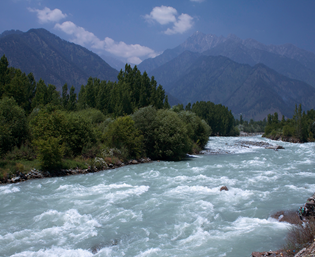A 1.5-year-old DAG in a 150-year-old Institution By Mr. Mukul Jamloki, Dy. Director
It was on 14th December 2022 when our posting orders came while I was still attached as an
Assistant Director in the CRA Wing in the Headquarters Office, New Delhi. To my surprise, my
first posting had come up in Kolkata. I chuckled to myself that Kolkata wouldn’t have featured
in my three preferences even in the wildest of my dreams. However, for once, I decided to swim
along the flow, and decided to chin up for any challenges on my way. With these thoughts, I
joined the office of the Principal Accountant General (A&E) West Bengal, Kolkata on 02.01.2023.
It was a journey full of surprises and lessons.
 The beginning of the Office of the Comptroller and Auditor General of India can be traced to the
year 1858 – the year the British Crown took over the reins of governing the British India
territories from the East India Company and called the office as the Accountant General to the
Government of India. Later, the office was designated as the Auditor General of India in 1860.
Hon’ble Sir Edmund Drummend was the first Auditor General of India who took charge on 16th
November 1860 and held office for sixteen months. The A&E office was established in 1865, as the
Auditor & Accountant General of the Dominion of India with his deputies as Accountants General.
Sri H. Sandeman was the first Accountant General of Bengal. Sir CV Raman had worked as Assistant
Accountant General in the office of the erstwhile Accountant General (Bengal) which was housed
in Treasury Buildings at Kolkata. Sir Raman had also served at Rangoon and Nagpur while he was
with the Department.
The beginning of the Office of the Comptroller and Auditor General of India can be traced to the
year 1858 – the year the British Crown took over the reins of governing the British India
territories from the East India Company and called the office as the Accountant General to the
Government of India. Later, the office was designated as the Auditor General of India in 1860.
Hon’ble Sir Edmund Drummend was the first Auditor General of India who took charge on 16th
November 1860 and held office for sixteen months. The A&E office was established in 1865, as the
Auditor & Accountant General of the Dominion of India with his deputies as Accountants General.
Sri H. Sandeman was the first Accountant General of Bengal. Sir CV Raman had worked as Assistant
Accountant General in the office of the erstwhile Accountant General (Bengal) which was housed
in Treasury Buildings at Kolkata. Sir Raman had also served at Rangoon and Nagpur while he was
with the Department.
AThe A&E office in Kolkata is situated in a British-era building called the Treasury Building, built in 1882 during the tenure of Lord Rippon. When one sees it for the first time, one feels like having been transported back to that era. Like most colonial buildings its architecture is hybridised - a mix of Gothic and Renaissance. The building was erected for the accommodation of the offices of the Government of India in the Financial Department. It was the site where the famous Spence’s hotel was located. It was the first ever hotel in Asia which was opened to the public in 1830. Later the Government acquired the land to build the Treasury Building and Spence’s was shifted to Wellesley Place near Governor's house.
I reached office a bit early on the first day around 9:15 AM in the morning, and to my surprise not a soul could be seen around. It seemed like the ghost of Rippon still haunted the Treasury Building. Gradually I realized that people used almost every means of transport fathomable to reach their offices in Kolkata: river ferries, buses, local trains, long-distance trains, metro trains, electric trams, auto-rickshaws, cycle-rickshaws, etc. which makes the Dalhousie Square (i.e., the BBD Bagh) area one of the most densely populated government spaces anywhere in our country. One of the first things that I observed about Kolkata was that it was perhaps one of the biggest stations in terms of IA&AD personnel. In fact, it has 11 HOD-level offices and three branch offices. The first two weeks were spent in calling upon different HODs and their Group Officers. The A&E Office was an incredible experience for me, having spent time both in managing Accounts and Funds at different points in time. Managing so many human resources directly in one’s first posting itself was challenging to say the least. The PIP of the office is nearly 1000 even if one excludes the DA cadre, with nearly 350 people in the Accounts group and nearly 200 in the Funds group. Many a times, I’d end up spending more time on things which weren’t directly in my charge. Hence it took me a while to carve out any value-addition that I could do in the office.
My first charge was that of DAG Funds. The GPF A/Cs were nearly automated since e-GPF statements with QR Code and facsimile signature had been introduced in 2021 for viewing and downloading for the more than 2.75 lakh live GPF subscribers in the state. Implementing the Change Management System for this initiative is indeed an incredible achievement for this office. The State Government and many employee unions also praised the office for this initiative, which got a good media coverage as well. It was the last phase of automation that was missing where the physical data entry needed to be replaced with automatic data upload as sent to the AG Office via the State Government’s IFMS. I remember that some of the most valuable lessons on how a Group Officer should go about managing their work, were shared by my PAG over a cup of Darjeeling laal chaai.

Day 1 in Kolkata
In June 2023, I was transferred to the Accounts Group which turned out to be a great place to learn. West Bengal is a big state, having more than 15000 DDOs. And as a result, it was just mind-boggling to go through the plethora of communications received from the State Government, the RBI, or the Treasuries. There would be a meeting with the State Government almost every fortnight on some initiatives or development that had come up. E-accounts, VLC Change Management, E-wallet and Just-in-Time-Funding were some of the most actively worked upon projects. I felt that the learning curve was extremely sharp. In addition to that, one had to manage the Divisional Accountants cadre. My seniors had both guided and forewarned me about it.
One of the lacunae that I observed in the Accounts Group was that some parts of the MSO Accounts had become outdated such as: examination of accounts by the Central Treasury Section, scrutiny of accounts in the Compilation Section, or managing the accounts of public works. Therefore nobody was sure about the actual processes going on in the sections. The officials were carrying on their duties according to their own predilections. As a result, the writ of the SAOs ran large among the sections. I decided that this were one of the most important things that I wanted to work upon. Our office was implementing the Middleware Server project and had got delayed, first due to the Covid-19 pandemic and then due to intransigence of the State Government. As a result, even the executing vendor had also stopped working. Thanks to my AG who included me in various discussions and deliberations, I learned valuable lessons in Project Management: deciding milestones and timelines, negotiating with the vendor, bringing all stakeholders on a common ground, etc. The time spent in figuring out the possible solutions to come out of the quagmire involving the different stakeholders, when I look back today, shall surely help me deal with tougher and more demanding situations in career going forward.
A unique example of an institution within an institution is the Treasury Buildings Institute of the IA&AD in Kolkata, established in June 1920. Presumably the oldest among the libraries in the IA&AD, the Treasury Buildings Institute Library (estd. 1932) has over the years had a host of renowned personalities from different fields as visitors such as Shri Soumitra Chatterjee and Sushri Mahashweta Devi to name a few, had showered encomium upon the richness and variety of collection of books here. During the lunch hours, the library was open for readers to get the books issued. However, the books management software was archaic and I was surprised to come to know that post Covid-19, the books were being issued via a register. Nearly 20% of the books were perhaps damaged due to improper storage. I was determined to change this and bring a new library management system

The Institute Hall which we wanted to renovate
One of my best memories from the A&E Office was when my PAG asked me to recce a few heritage buildings in the BBD Bagh area to get new design ideas for the renovation of the Treasury Buildings Hall & Library and the original conference room of the AG Bengal, located on the second floor. These locations are used to conduct programs and functions on important occasions. However, they were in a dilapidated condition and the humid weather made it even more difficult to sit inside. I got an opportunity to visit places such as Asiatic Society, the Currency Building, the Metcalfe Hall, the Indian Museum, and the National Library. It was a fantastic experience, getting a first-hand taste of the British era external architecture and interiors. With the help of left-over funds from the Audit Diwas 2022, we renovated the Conference Room of AG Bengal. We also came across an interior design firm that had renovated many ASI-controlled buildings such as the Metcalfe Hall, hired them to give us design ideas for the Hall and the Library.
Using the same funds, I even got an opportunity to guide a team of scriptwriters and videographers to prepare a documentary on the history of the IA&AD in Kolkata where we covered all the 14 offices in the station. It was challenging because we had a very limited budget and it was March ending, hence we had to do the entire shoot within two days. Negotiating with the producer about the cost and finalizing the script and the screenplay was tricky. The entire experience involving the utilisation of the Audit Diwas funds was overwhelming. On one end there was a feeling of accomplishment about the tasks which had been completed such as the video. On the other end there was a feeling of disappointment that preparing the design ideas was just the first step, following it up with the CPWD via the Estates Committee of the station was the most arduous task especially when the Estate function wasn’t in our control. And that was the learning, not all problems are meant to be solved immediately. Some solutions take their own sweet time to come up and there’s no point breaking our heads over it.
The historic and august Conference Room of AG Bengal after the renovation, with the new trophy cabinets at the back. Some cabinets have also been placed in the main corridor of the AG Bengal building for the visitors.

Some of the old Accounts of West Bengal have now been displayed in the Conference Room that highlight the legacy of the more than 150 years old institution of AG Bengal. One can access the archives of this historic institution at https://cag.gov.in/ae/west-bengal/en/page-ae-west-bengal-archives where one can find books, manuals and accounts dating to 1864. Going through them is truly a fascinating and a cathartic experience.

On 03.01.2024, I got my intra-city transfer orders and was posted in the O/o the DG Audit, Ordnance Factories. It was difficult to process at first because I felt that I was in the middle of a lot of tasks getting executed, and still had a lot of ideas to work upon. However, a dear friend asked me to compose myself and said these beautiful words to me: “We are birds of passage. We are not meant to build our nests anywhere.” Civil servants should never attach themselves to their work or their workplaces. They may take their work seriously but shouldn’t take themselves seriously. However, whatever work they do, they should maintain utmost sincerity in it.
What I remember above all about the A&E Office was being amidst so much energy and excitement, and even confusion sometimes. It could be exhilarating, intimidating, sometimes even discouraging, but always challenging. It was an amazing privilege – and though I left early, I was certainly transformed by the time I spent at the A&E Office, the professional and personal relationships that I made, and the ideas I worked on. Being associated with an office which was perhaps the oldest institution (dating to the early1860s) of the O/o the CAG of India, which today is a Constitutional body, shall forever remain one of the most cherished memories of my life.

Some of the most cherished personal and professional relationships
Continue Reading

From the Editor's Desk
Forty years ago, recognising the knowledge driven nature of our Institution, the quarterly publication of the “Journal of Management and Training” was initiated....

Reporting for impact - Improving readability of audit reports
The need for enhancing the value and impact of CAG’s audit has been an enduring concern...

Application of Machine Learning Algorithms in Audit
There has been a tremendous explosion of data available with public sector entities over the last 20 years...

Digital Accountability: Harnessing Photo Forensics for e-Services Audits
In an era where technology intertwines with governance, the shift towards online portals for delivering public services has been monumental...

Accessibility of Cutting-Edge Technologies in GIS and RS
The democratization of cutting-edge technologies such as Geographic Information Systems (GIS) and Remote Sensing stands as a huge shift, empowering...

Beneficiaries of Social Schemes and Assessment
Social programmes have evolved over the decades, aiming for increased coverage, higher entitlements, and better design by using technology for targeting...

Blue Carbon Accounting
Human beings thrive in diverse ecosystems but often simplify these ecosystems over time. This simplification occurs through targets...

Generative AI: The Age of Artificial Imagination
In the vast landscape of artificial intelligence, few innovations have captured the imagination of the humans and sparked as much excitement as...

Water Resource Accounting in India
Water: The word itself is an indication of life on the planet. About 60% of the human body contains water...



